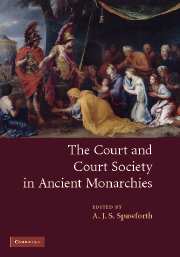Book contents
- Frontmatter
- Contents
- List of figures
- List of tables
- Notes on contributors
- Acknowledgements
- List of abbreviations
- Introduction
- 1 New out of old? Court and court ceremonies in Achaemenid Persia
- 2 King, court and royal representation in the Sasanian empire
- 3 The court of Alexander the Great between Europe and Asia
- 4 Friends in high places: the creation of the court of the Roman emperor
- 5 The imperial court of the late Roman empire, C. AD 300–C. AD 450
- 6 The imperial court in Han China
- 7 Court and palace in ancient Egypt: the Amarna period and later Eighteenth Dynasty
- Bibliography
- Index
6 - The imperial court in Han China
Published online by Cambridge University Press: 22 September 2009
- Frontmatter
- Contents
- List of figures
- List of tables
- Notes on contributors
- Acknowledgements
- List of abbreviations
- Introduction
- 1 New out of old? Court and court ceremonies in Achaemenid Persia
- 2 King, court and royal representation in the Sasanian empire
- 3 The court of Alexander the Great between Europe and Asia
- 4 Friends in high places: the creation of the court of the Roman emperor
- 5 The imperial court of the late Roman empire, C. AD 300–C. AD 450
- 6 The imperial court in Han China
- 7 Court and palace in ancient Egypt: the Amarna period and later Eighteenth Dynasty
- Bibliography
- Index
Summary
Introduction
A book on the imperial court of ancient China's Han dynasty has yet to be written. Most specialists working in the early China field see the court as one specific part of central administration and descriptions subsume it under this category. Thus, the court is seen as the central institution which some offices belonged to, whereas the heads and senior members of other offices and ministries went there from time to time in order to discuss matters which were important for the empire. As well as being constituted by the imperial household, the Han court was also the place where high officials were convened from time to time, especially when court audiences took place at which, at least in theory, people could speak up freely. Although Michael Loewe has described the Han concept of sovereignty, he did not stress the importance of the court as an institution. Of course, there are historiographical descriptions of political intrigues going on at specific times. Hans Bielenstein has characterised the history of the Later Han period in terms of power struggles between two or three large factions, each consisting of a clan, which in turn represented several families interrelated by marriage. These factions alternately dominated the court, making it work for the interests of the clan, which had its power-base far away from the capital.
- Type
- Chapter
- Information
- The Court and Court Society in Ancient Monarchies , pp. 233 - 266Publisher: Cambridge University PressPrint publication year: 2007
- 21
- Cited by



